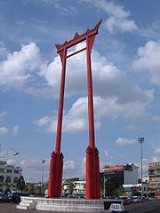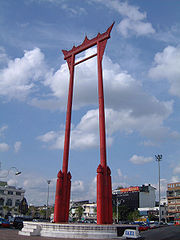
Giant Swing
Encyclopedia

Bangkok
Bangkok is the capital and largest urban area city in Thailand. It is known in Thai as Krung Thep Maha Nakhon or simply Krung Thep , meaning "city of angels." The full name of Bangkok is Krung Thep Mahanakhon Amon Rattanakosin Mahintharayutthaya Mahadilok Phop Noppharat Ratchathani Burirom...
, Thailand
Thailand
Thailand , officially the Kingdom of Thailand , formerly known as Siam , is a country located at the centre of the Indochina peninsula and Southeast Asia. It is bordered to the north by Burma and Laos, to the east by Laos and Cambodia, to the south by the Gulf of Thailand and Malaysia, and to the...
, Phra Nakhon district
Phra Nakhon
Phra Nakhon is one of the 50 districts of Bangkok, Thailand. It is the central district of Bangkok, including the Rattanakosin Island...
, located in front of Wat Suthat
Wat Suthat
Wat Suthat Thepphawararam is a royal temple of the first grade, one of ten such temples in Bangkok . Construction was begun by His Majesty King Rama I in 1807 . Further construction and decorations were carried out by King Rama II who helped carve the wooden doors, but the temple was not completed...
temple. It was formerly used an old Brahmin
Brahmin
Brahmin Brahman, Brahma and Brahmin.Brahman, Brahmin and Brahma have different meanings. Brahman refers to the Supreme Self...
ceremony, and is one of Bangkok's tourist attractions.
History
The Giant Swing was originally constructed in 1784 in front of the Devasathan shrine by King Rama I. During the reign of Rama IIBuddha Loetla Nabhalai
Phra Bat Somdet Phra Poramenthramaha Isarasundhorn Phra Buddha Loetla Nabhalai , or Rama II , was the second monarch of Siam under the House of Chakri, ruling from 1809-1824. In 1809, Isarasundhorn succeeded his father Buddha Yodfa Chulaloke, the founder of Chakri dynasty, as Buddha Loetla Nabhalai...
the swing ceremony was discontinued as the swing had become structurally damaged by lightning. In 1920 it was renovated and moved to its current location in order to make space for a gas plant. The ceremony was again performed until 1935, when it was discontinued after several fatal accidents.
The last renovations were done in 1959, and after 45 years of exposure to the elements the wooden pillars were showing signs of serious damage. A major reconstruction began in April 2005. Six teak tree trunks were used. The two used for the main structure of the swing are over 3.5m in circumference and over 30m in height. The remaining four are used for support and are 2.30m in circumference and 20m in height. The swing was taken down in late October 2006 and the work finished late December of the same year. The rebuilt swing was dedicated in royal ceremonies presided over by His Majesty King Bhumibol Adulyadej
Bhumibol Adulyadej
Bhumibol Adulyadej is the current King of Thailand. He is known as Rama IX...
in September 2007. The timbers of the original swing are preserved in the National Museum
National Museum (Thailand)
The National Museum in Thailand is the main museum on the history of the Thai culture. The main museum is located in Bangkok on Na Phrathat Road next to the Sanam Luang, not far from Wat Phra Kaew....
.
In 2005, the Giant Swing, together with Wat Suthat, was suggested as a future UNESCO World Heritage Site.
Swing Ceremony
The Ceremony of Tri-yampawai or the Swing Ceremony was one of the 12 royal ceremonies held in each of the months of the Thai lunar calendarThai lunar calendar
The Thai lunar calendar , or Dai calendar , Tai calendar, is Thailand's version of the lunisolar Buddhist calendar used in the southeast Asian countries of Cambodia, Laos and Burma, for calculating lunar-regulated holy days...
in the Sukhothai kingdom
Sukhothai kingdom
The Sukhothai Kingdom ) was an early kingdom in the area around the city Sukhothai, in north central Thailand. The Kingdom existed from 1238 till 1438...
. Originally held in the first lunar month, it was moved to the second lunar month in the early Rattanakosin period at the beginning of the 19th century. The ceremony was a Bhramin new year's ceremony and lasted for 10 days.
According to an ancient Hindu
Hindu
Hindu refers to an identity associated with the philosophical, religious and cultural systems that are indigenous to the Indian subcontinent. As used in the Constitution of India, the word "Hindu" is also attributed to all persons professing any Indian religion...
epic, after Brahma
Brahma
Brahma is the Hindu god of creation and one of the Trimurti, the others being Vishnu and Shiva. According to the Brahma Purana, he is the father of Mānu, and from Mānu all human beings are descended. In the Ramayana and the...
created the world he sent Shiva
Shiva
Shiva is a major Hindu deity, and is the destroyer god or transformer among the Trimurti, the Hindu Trinity of the primary aspects of the divine. God Shiva is a yogi who has notice of everything that happens in the world and is the main aspect of life. Yet one with great power lives a life of a...
to look after it. When Shiva descended to the earth, Naga
Naga
Naga or NAGA may refer to:* Nāga, a group of serpent deities in Hindu and Buddhist mythology.-People:* Nayan / Nayar/Nair people of Kerala Society* Naga people, a diverse ethnic identity in Northeast India...
serpents wrapped around the mountains in order to keep the earth in place. When Shiva found the earth solid, the Nagas moved to the seas in celebration. The Swing Ceremony is a re-enactment of this story. The pillars of the Giant Swing represent the mountains, while the circular base of the swing represents the earth and the seas. In the ceremony Brahmins swing, trying to grab a bag of coins placed on one of the pillars.

